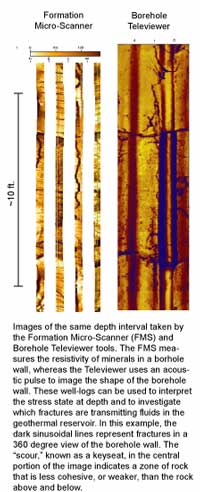
|
Project Title: Investigating Host Rock Mineralogical
and Petrophysical Controls on Fracture Permeability in the Coso Geothermal Field,
California Mendenhall Fellow: Nicholas C. Davatzes (650) 329-4024, ndavatzes@usgs.gov Duty Station: Menlo Park, CA Start Date: March 15, 2004 Education: Ph.D., 2003, Stanford University, Geological and Environmental Sciences (specializing in quantitative structural geology and geomechanics) Research Advisors: Steve Hickman (650) 329-4807, hickman@usgs.gov; Steve Ingebritsen (650)329-4422, seingebr@usgs.gov; Colin Williams (650)329-4881,colin@usgs.gov |
Project Description: Although fracture permeability is a primary control on productivity of geothermal reservoirs, the mechanical and chemical factors controlling fracture permeability at hydrothermal conditions are poorly understood. For instance, many geothermal systems in the Great Basin of the western United States are rooted in extensive fracture networks that comprise the damage zones of large, active faults (Benoit and Butler, 1983; Forster and others, 1997). Yet active precipitation of minerals in hydrothermal systems implies that fractures conducting fluids in the subsurface will heal and permeability will be lost. To address this issue, this project is conducting a detailed study of how mineralogical and petrophysical properties control the failure mode and resulting permeability of newly formed or reactivated fractures in chemically altered granite within an active geothermal field. The primary data sets are derived from fracture mapping and petrographic analyses on surface outcrops and drill cores altered to different degrees from the Coso Geothermal Field (CGF). These data sets are compared with borehole and laboratory core measurements of fracture permeability, fracture orientation, in-situ stress and petrophysical properties to determine how permeability generation by fracturing depends on the nature and extent of hydrothermal alteration and competes with chemical precipitation in a fractured hydrothermal system.
Active deformation, hydrothermal alteration, extensive outcrop exposure, the availability of core, and abundant subsurface data make the Coso Geothermal Field (CGF) an ideal natural laboratory to address these issues. The CGF is located in fractured granites above a partially molten silicic magma chamber 5 km below the surface (Manley and Bacon, 2000; Adams and others, 2000; Lees, 2001; Wilson and others, in preparation). Over 100 wells have been drilled since power generation at the field began, and temperatures up to 342° C (Lutz and others, 1996) have been measured in wells at the central part of the field. Hydrothermal fluids circulate through fracture systems associated with normal and strike–slip faults accommodating up to 30 mm of extension each year (Wicks and others, 2001) and ongoing seismicity occurring at an average rate of 20 micro-earthquakes per day (Malin, 1994). The field currently produces about 270 MW of electricity (1MW is roughly enough to power one thousand urban homes) and is the subject of a multi-disciplinary study, the Coso Enhanced Geothermal Systems (EGS) Project. The Coso EGS Project is studying how to improve power production through characterization of stresses, fracturing, mineralogy, geochemical environment, and fluid flow within the existing reservoir and then using this information to artificially enhance reservoir permeability through large-scale fluid injection. This Mendenhall will benefit from a number of collaborations between Nick Davatzes and researchers involved in the Coso EGS project.
 |
VIEW a high-resolution PDF file
|

|
VIEW a high-resolution PDF file
|
|
|
REFERENCES Adams, M.C., Moore, J.N., Bjornstad, S., and Norman, D.I., 2000, Geologic history of the Coso geothermal system, in Proceedings of the World Geothermal Congress 2000: Kyushu–Tohoku, Japan, May 28–June 10, 2000, 7 p. Benoit, W.R., and Butler, R.W., 1983,. A review of high-termperature geothermal developments in the northern Basin and Range province: Geothermal Resources Council Special Report 13, p. 57–74. Duffield, W. A, and Bacon, C. R., 1981, Geologic map of the Coso volcanic field and adjacent areas, Inyo County, California: U. S. Geological Survey Miscellaneous Investigations Map I–1200, 1 sheet.. Echols, T. J., Hulen, J. B., Moore, J. N., and Crane, G. K., 1986, Surficial alteration and spring deposits of the Wheeler mercury prospect, with initial results from Wheeler Corehole 64-16, Coso geothermal area, California, in Geothermal energy: A milestone year: Transactions of the Geothermal Resources Council, v. 10, p. 175–180. Forster, C.B., Caine, J.S., Shultz, S., and Nielson, D.L., 1997, Fault zone architecture and fluid flow: an example from Dixie Valley, Nevada: Proceedings of the 22d workshop on geothermal reservoir engineering: Stanford, Calif., Stanford University Report SGP-TR-155, p. 123–130. Hulen, J. B., 1978, Geology and alteration of the Coso geothermal area, Inyo County, California. U.S. Department of Energy Report IDO-1701-1, 38 p. Lees, J.M., 2001, Three-dimensional anatomy of a geothermal field, Coso, southeast-central California, in Geologic evolution of the Mojave Desert and southwestern Basin and Range: Geological Society of America Memoir 195, p. 259–276. Lutz, S.J., Moore, J.N., and Copp, J.F., 1996, Integrated mineralogical and fluid inclusion study of the Coso geothermal system, California:. Proceedings of the 21st workshop on geothermal reservoir engineering: Stanford, Calif., Stanford University, p. 187–194. Malin, P.E. 1994. The seismicity of extensional hydrothermal systems: Geothermal Research Council Transactions, v. 18, p. 17–22. Manley, C.R., and Bacon, C.R., 2000, Rhyolite thermobarometry and the shallowing of the magma reservoir, Coso Volcanic Field, California: Journal of Petrology, v. 41, p. 149–174. Roquemore, G., 1981. Active faults and associated tectonic stress in the Coso Range, California:. China Lake, Calif., Naval Weapons Center, 101 p. Whitmarsh, R.C. 1998. Structural development of the Coso Range and adjacent areas of eastern California [Ph.D. thesis]: Lawrence, University of Kansas. Wicks, C., Thatcher, W., Moastero, F., and Hasting, M., 2001, Steady-state deformation of the Coso Range, east-central California, inferred from satellite radar interferometry: Journal of Geophysical Research, v. 106, p. 13769–13780. Wilson, C.K., Jones, C.H., and Gilbert, H.J., in preparation, Single-chamber silicic magma system inferred from shear-wave discontinuities of the crust and uppermost mangle, Coso Geothermal Area, California. |
||||
|
|
Previous Profile | Project Profiles | Next Profile |
|
<URL:http://geology.usgs.gov/postdoc/profiles/davatzes.html>
Maintained by: Eastern Publications Group Web Team
Last updated 2-June-2004 (krw)